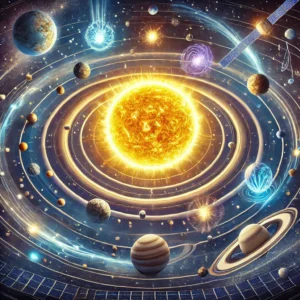The Sun’s Role in the Solar System: Gravitational Influence and Energy Supply
 The Sun’s Role in the Solar System: Gravitational Influence and Energy Supply
The Sun’s Role in the Solar System: Gravitational Influence and Energy Supply
The Sun, at the center of the solar system, is the most massive object and plays a vital role in shaping and sustaining the dynamics of the planets, moons, asteroids, and comets orbiting it. Its gravitational pull and immense energy output are fundamental to the functioning of the solar system.
Gravitational Influence
- Orbital Stability:
- The Sun’s immense mass (approximately 99.8% of the solar system’s total mass) creates a powerful gravitational field that keeps planets and other celestial bodies in stable orbits.
- This gravitational pull ensures the orderly arrangement of the solar system, with each planet following a specific elliptical path.
- Tidal Effects:
- The Sun, along with the Moon, influences tidal forces on Earth. Solar tides combine with lunar tides to create spring and neap tides.
- Interplanetary Dynamics:
- The Sun’s gravity governs the motion of comets and asteroids, pulling them into the inner solar system or stabilizing them in the Kuiper Belt and Oort Cloud.
Energy Supply
- Nuclear Fusion:
- The Sun generates energy through nuclear fusion in its core, where hydrogen nuclei fuse to form helium, releasing vast amounts of energy.
- This energy radiates outward in the form of light and heat, which sustain life on Earth.
- Photosynthesis and Climate Regulation:
- Solar energy drives photosynthesis in plants, forming the base of Earth’s food chain.
- The Sun regulates Earth’s climate and weather patterns by providing consistent energy that influences atmospheric circulation and ocean currents.
- Solar Wind and Space Weather:
- Streams of charged particles emitted by the Sun, known as the solar wind, interact with planetary magnetospheres, creating phenomena like auroras on Earth.
- Solar activity, such as flares and coronal mass ejections, influences space weather, affecting satellites, power grids, and communication systems.
The Sun’s Lifecycle and Its Future Role
- Currently in its main sequence phase, the Sun will remain stable for another 5 billion years.
- Over time, it will expand into a red giant, potentially engulfing inner planets like Mercury and Venus, before shedding its outer layers and becoming a white dwarf.
The Sun’s gravitational and energy roles make it the cornerstone of the solar system, directly influencing the conditions that allow Earth to sustain life. Its life cycle also highlights the evolving nature of celestial systems.
https://zireemilsoude.net/4/8592093
What's your reaction?
Excited
0
Happy
0
In Love
0
Not Sure
0
Silly
0







